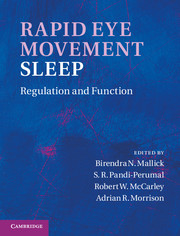Book contents
- Frontmatter
- Contents
- Contributors
- Preface
- Acknowledgments
- Organization
- Section I Historical context
- Section II General biology
- Section III Neuronal regulation
- Section IV Neuroanatomy and neurochemistry
- Section V Functional significance
- Section VI Disturbance in the REM sleep-generating mechanism
- 40 Narcolepsy and REM sleep
- 41 REM sleep and dreams: relationship to anxiety, psychosomatic, and behavioral disorders
- 42 REM sleep and emotion regulation
- 43 Neural modeling for cooperative/competitive regulation of REM sleep with NREM sleep and wakefulness
- 44 The selective mood-regulatory theory of dreaming: an adaptive, assimilative, and experimentally based theory of dreaming
- Index
- Plate section
- References
41 - REM sleep and dreams: relationship to anxiety, psychosomatic, and behavioral disorders
from Section VI - Disturbance in the REM sleep-generating mechanism
Published online by Cambridge University Press: 07 September 2011
- Frontmatter
- Contents
- Contributors
- Preface
- Acknowledgments
- Organization
- Section I Historical context
- Section II General biology
- Section III Neuronal regulation
- Section IV Neuroanatomy and neurochemistry
- Section V Functional significance
- Section VI Disturbance in the REM sleep-generating mechanism
- 40 Narcolepsy and REM sleep
- 41 REM sleep and dreams: relationship to anxiety, psychosomatic, and behavioral disorders
- 42 REM sleep and emotion regulation
- 43 Neural modeling for cooperative/competitive regulation of REM sleep with NREM sleep and wakefulness
- 44 The selective mood-regulatory theory of dreaming: an adaptive, assimilative, and experimentally based theory of dreaming
- Index
- Plate section
- References
Summary
Summary
Sleep disturbances are frequently associated with, and can comprise core features of, anxiety disorders. Studies using objective sleep recordings have demonstrated impaired sleep initiation and maintenance in persons with generalized anxiety disorder or panic disorder, but a normal latency to REM sleep. Increased phasic motor activity and eye movement density during REM sleep have been reported in combat veterans with post-traumatic stress disorder: moreover, nightmares and other symptomatic awakenings disproportionately arise from REM sleep.
One of the most consistent behavioral manifestations of sleep loss is the worsening of mood state. With prolonged sleep deprivation it is possible to observe an increase in self-reported feelings of depressed mood, anger, frustration, and anxiety. Interestingly, there is little evidence that waking stress leads to increased REM, although there have been reports of small elevations in REM following severe emotional upset. REM sleep might have some sort of calming effect.
The relationship between somatic distress and dream disturbance has been recently investigated: individuals who reported more incidents of both bad dreams and nightmares did report higher levels of somatic distress. However, REM sleep behavior disorder (RBD), a parasomnia characterized by complex and often violent motor behaviors that emerge from REM sleep and that are associated with violent and unpleasant dreams, represents a particular condition. A discrepancy between the aggressiveness displayed in dreams and the placid and mild-mannered temperament has been observed in patients with RBD.
- Type
- Chapter
- Information
- Rapid Eye Movement SleepRegulation and Function, pp. 417 - 426Publisher: Cambridge University PressPrint publication year: 2011



